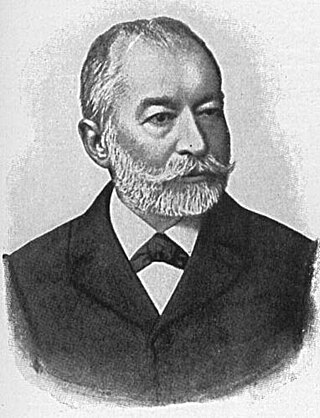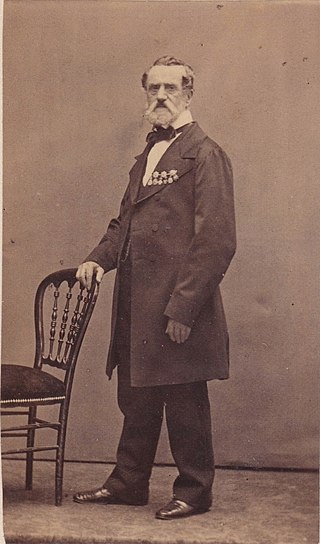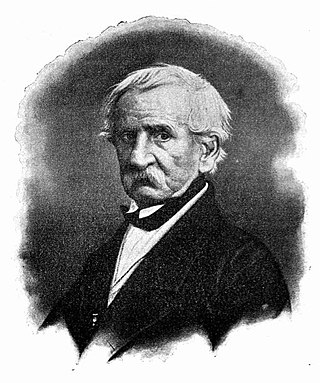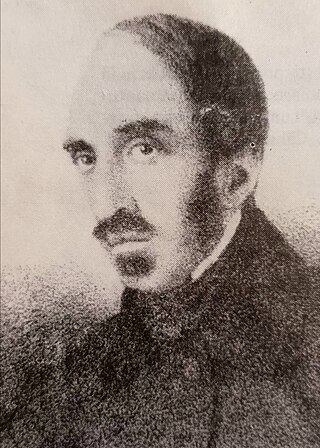
Moldavia is a historical region and former principality in Central and Eastern Europe, corresponding to the territory between the Eastern Carpathians and the Dniester River. An initially independent and later autonomous state, it existed from the 14th century to 1859, when it united with Wallachia as the basis of the modern Romanian state; at various times, Moldavia included the regions of Bessarabia, all of Bukovina and Hertsa. The region of Pokuttya was also part of it for a period of time.

Dimitrie Sturdza was a Romanian statesman and author of the late 19th century, and president of the Romanian Academy between 1882 and 1884.

Mihail Kogălniceanu was a Romanian liberal statesman, lawyer, historian and publicist; he became Prime Minister of Romania on October 11, 1863, after the 1859 union of the Danubian Principalities under Domnitor Alexandru Ioan Cuza, and later served as Foreign Minister under Carol I. He was several times Interior Minister under Cuza and Carol. A polymath, Kogălniceanu was one of the most influential Romanian intellectuals of his generation. Siding with the moderate liberal current for most of his lifetime, he began his political career as a collaborator of Prince Mihail Sturdza, while serving as head of the Iași Theater and issuing several publications together with the poet Vasile Alecsandri and the activist Ion Ghica. After editing the highly influential magazine Dacia Literară and serving as a professor at Academia Mihăileană, Kogălniceanu came into conflict with the authorities over his Romantic nationalist inaugural speech of 1843. He was the ideologue of the abortive 1848 Moldavian revolution, authoring its main document, Dorințele partidei naționale din Moldova.

The House of Ghica [or Ghika] was a noble family whose members held significant positions in Wallachia, Moldavia and later in the Kingdom of Romania, between the 17th and 19th centuries. The Ghica family produced many voivodes of Wallachia and Moldavia and two Prime Ministers of Romania. Several branches of the family still exist today.

Mihail Sturdza, sometimes anglicized as Michael Stourdza, was prince ruler of Moldavia from 1834 to 1849. He was cousin of Roxandra Sturdza and Alexandru Sturdza.

Prince Alexandru Sturdza was a Russian publicist and diplomat of Romanian origin. In his writings, he referred to himself with a French rendition of his name, Alexandre Stourdza.

Grigore Mihail Sturdza, first name also Grigorie or Grigori, last name also Sturza, Stourdza, Sturd̦a, and Stourza, was a Moldavian, later Romanian soldier, politician, and adventurer. He was the son of Prince Mihail Sturdza, a scion of ancient boyardom, and, during the 1840s, an heir apparent to the Moldavian throne, for which he was known throughout his later life as Moldavia's Beizadea. A rebellious youth famous for his feats of strength, he set up his own private militia which he used to corner the Moldavian grain trade, and entered a legal battle with Sardinian retailers. In 1845, he defied his father, and French law, by seeking to marry the much older, already married Countess Dash, and barricaded himself with her at Perieni. By 1847, Grigore had been reintegrated into the Moldavian establishment, and, as a general in the Moldavian princely militia, personally handled repression during the attempted revolution of April 1848. During these events, the Beizadea became personal enemies with three future statesmen—Alexandru Ioan Cuza, Mihail Kogălniceanu, and Manolache Costache Epureanu.

The House of Cantacuzino is a Romanian aristocratic family of Greek origin. The family gave a number of princes to Wallachia and Moldavia, and it claimed descent from a branch of the Byzantine Kantakouzenos family, specifically from Byzantine Emperor John VI Kantakouzenos. After the Russo-Ottoman War of 1710–11, a lateral branch of the family settled in Russia, receiving the princely status. In 1944, Prince Ștefan Cantacuzino settled in Sweden, where his descendants form part of the unintroduced nobility of that country.

Grigore Alexandru Ghica or Ghika was a Prince of Moldavia between 14 October 1849, and June 1853, and again between 30 October 1854, and 3 June 1856. His wife was Helena, a member of the Sturdza family and daughter of Ioan Sturdza, who had been Prince of Moldavia from 1822 to 1828.

Gheorghe Asachi was a Moldavian, later Romanian prose writer, poet, painter, historian, dramatist, engineer, border maker, and translator. An Enlightenment-educated polymath and polyglot, he was one of the most influential people of his generation. Asachi was a respected journalist and political figure, as well as active in technical fields such as civil engineering and pedagogy, and, for long, the civil servant charged with overseeing all Moldavian schools. Among his leading achievements were the issuing of Albina Românească, a highly influential magazine, and the creation of Academia Mihăileană, which replaced Greek-language education with teaching in Romanian. His literary works combined a taste for Classicism with Romantic tenets, while his version of the literary language relied on archaisms and borrowings from the Moldavian dialect.

Elena Cuza, also known under her semi-official title Elena Doamna, was a Moldavian, later Romanian noblewoman and philanthropist. She was princess consort of the United Principalities and the wife of Alexandru Ioan Cuza, the first Romanian prince.
Alexandru Hrisoverghi was a Moldavian Romanian-language poet and translator, whose work was influenced by Romanticism. The author of few lyrical works, he was foremost noted for his association with political and intellectual figures such as Mihail Kogălniceanu, Costache Negruzzi, Vasile Cârlova, and Grigore Crupenschi.
The Moldavian Revolution of 1848 is the name used for the unsuccessful Romanian liberal and Romantic nationalist movement inspired by the Revolutions of 1848 in the principality of Moldavia. Initially seeking accommodation within the political framework defined by the Regulamentul Organic, it eventually rejected it as imposed by foreign powers and called for more thorough political reforms. Led by a group of young intellectuals, the movement was mostly limited to petitioning and constitutional projects, unlike the successful uprising taking place later that year in neighbouring Wallachia, and it was quickly suppressed. This was despite the fact that the Moldavian revolutionaries were more moderate and willing to compromise in their demands for reforms than their Wallachian counterparts, as Moldavian political and social life continued to be dominated by a landed, conservative aristocracy, with the middle class still embryonic.

Alexandru Papadopol-Calimah was a Moldavian-born Romanian historian, jurist, and journalist, who served as the Minister of Foreign Affairs and Minister of Culture of the Principality of Romania. As a maternal member of the Callimachi family, he had high aristocratic origins, but was a commoner on his father's side; he spent most of his life in the Moldavian town of Tecuci, whose history was a focus of his academic activity. He joined the Moldavian civil service in 1855, as a Spatharios in service to Prince Grigore Alexandru Ghica, and participated in applying Ghica's reforms. Papadopol-Calimah consequently discarded his Greek-and-Hellenized background to become an exponent of Romanian nationalism, supporting a political unification between Moldavia and Wallachia, which came about in 1859. He first served in the unified administration established by Domnitor Alexandru Ioan Cuza, rising from Prefect to State Council member, then to cabinet minister. Throughout his career, he remained closely aligned with Vasile Alecsandri and Mihail Kogălniceanu, and later also with Bogdan Petriceicu Hasdeu.

The House of Kogălniceanu, Kogălniceanul or Cogâlniceanu was one of the major political, intellectual and aristocratic families in Moldavia, with branches in modern Romania. Originally Bessarabian peasants, the first Kogălniceanus accumulated wealth and, as owners of the Scrivulenii (Râpile) estate, climbed into the boyar elite. They were also important as skilled members of the Moldavian bureaucracy, and, through brothers Constantin and Enache, also made contributions to 18th-century Romanian literature. Their work was matched and surpassed three generations later by possibly the most famous member of the family, historian and statesman Mihail Kogălniceanu, one of the founders of modern Romania and of Romanian liberalism.

Princess Roxandra or Roxana or Roksandra Skarlatovna Edling-Sturdza was a philanthropist and a writer. Her chief achievement was the foundation of schools and orphanages for the young and needy refugees in Odessa during the years of wars and revolutions in the Balkans. She was a grandchild of the Grand Dragoman or Prince of Moldavia Constantine Mourousis; that and her own actions, vision, will and determination made her a prolific advocate of young refugee needs all over Europe.

Dimitrie Ralet was a Moldavian political figure and celebrated contributor to Romanian literature. Belonging to the upper strata of boyardom, he was of Phanariote and Aromanian descent, and may not have been born in Moldavia; his family history, as well as the circumstances of his birth and early life, remain mysterious and controversial. His father, the Spatharios Alexandru Ralet, was a judge in the northern Moldavian city of Botoșani, and the owner of Bucecea town. Possibly educated abroad, and already a polyglot in his twenties, Dimitrie took over his father's job at the tribunal in 1841—but only served briefly, and with interruptions. He first published as a translator in 1837, before making his actual debut in 1840, with short essays in social satire that evidenced a deep familiarity with 18th-century French literature. Ralet was an introspective and self-deprecating adherent of Romanticism, whose youthful contributions helped establish a deadpan register in modern Romanian humor.

Ion Cuza or Cuzea, commonly known as Ioniță Cuza, was a Moldavian statesman and political conspirator, remembered as one of the first Romanian nationalists and Freemasons. His paternal family, the Cuzas (Cuzeas), were landowners of uncertain origin who, by the time of Ioniță's birth, had been established into the boyardom, being under the patronage of Doukas and Sturdza aristocrats. Ioniță's mother was a direct descendant of the statesman-chronicler Miron Costin; his father, Miron Cuza, had been involved in the pro-Habsburg conspiracy headed by François Ernaut, while his grandfather, Dumitrașco Cuzea, had been hanged during the clampdown. As boyars, both the Cuzas and the Costins opposed the Phanariote regime and devised other schemes to emancipate Moldavia from the Ottoman Empire.

Alecu Beldiman, common rendition of Alexandru Beldiman, also known as Alecul or Aleco Beldiman, was a Moldavian statesman, translator and poet, one of the forerunners of Romanian nationalism. A scion of the boyar elite, he was the eldest son of Vornic Gheorghe Beldiman, and the nephew-in-law of chronicler Enache Kogălniceanu. Alecu himself held high commission in the Moldavian military forces and bureaucracy, but secretly resented the Phanariote regime which had awarded them. He may have affiliated with a loose group known as the "National Party", championing an alliance between Moldavia's independence from the Ottoman Empire and support for the French Republic.

The House of Balș is an old Moldavian noble family, whose origins can be traced back to the 15th century and whose members played important political roles in the history of Moldavia and later Romania, Russia and Austria.
3. Otu, Petre, Georgescu, Maria: Durchleuchtung eines Verrats. Der Fall des Oberst Alexandru D. Sturdza. Lektor Verlag. Hainburg. 2022.



















